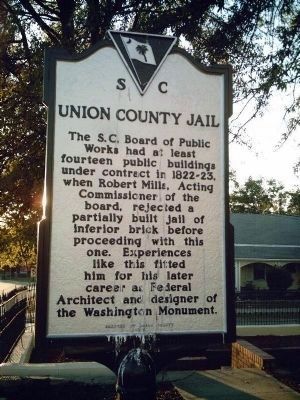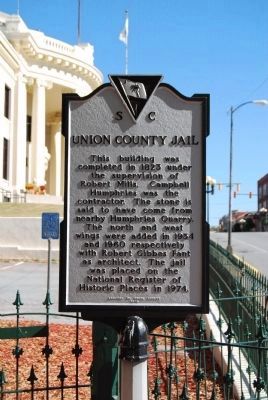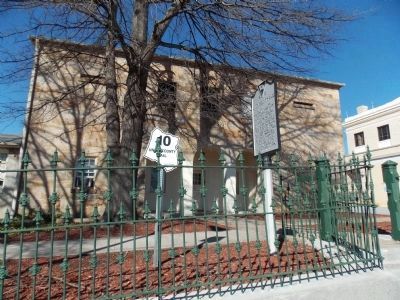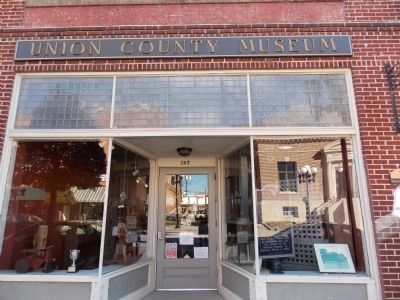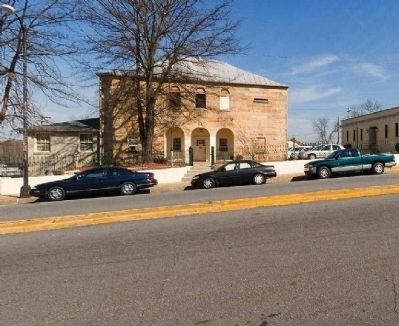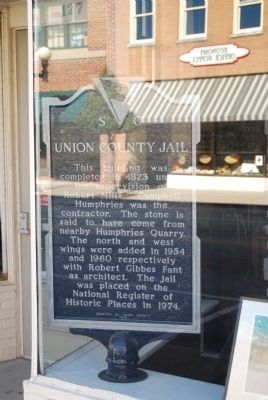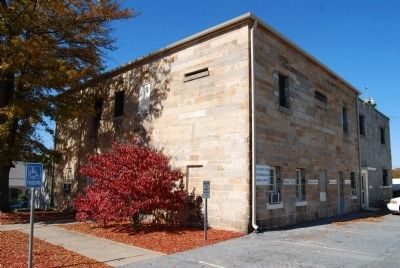Union in Union County, South Carolina — The American South (South Atlantic)
Union County Jail
[Front]:
The S. C. Board of Public Works had at least fourteen public buildings under contract in 1822-23, when Robert Mills, Acting Commissioner of the board, rejected a partially built jail of inferior brick before proceeding with this one. Experiences like this fitted him for his later career as Federal Architect and designer of the Washington Monument.
[Reverse]:
This building was completed in 1823 under the supervision of Robert Mills. Campbell Humphries was the contractor. the stone is said to have come from nearby Humphries Quarry. The north and west wings were added in 1954 and 1960 respectively with Robert Gibbes Fant as architect. The jail was placed on the National Register of Historic Places in 1974.
Erected 1976 by Union County. (Marker Number 44-5.)
Topics. This historical marker is listed in these topic lists: Charity & Public Work • Law Enforcement. A significant historical year for this entry is 1823.
Location. 34° 42.913′ N, 81° 37.568′ W. Marker is in Union, South Carolina, in Union County. Marker is at the intersection of Main Street (Route 49) and Enterprise Street on Main Street. Touch for map. Marker is in this post office area: Union SC 29379, United States of America. Touch for directions.
Other nearby markers. At least 10 other markers are within walking distance of this marker. Union County Lynchings of 1871 (a few steps from this marker); Lynching in America / Lynching in Union County after 1877 (within shouting distance of this marker); Reconstruction Era Lynchings in Union County / Union County Jail Raid Massacre (within shouting distance of this marker); John Pratt (within shouting distance of this marker); Union Community Hospital (about 300 feet away, measured in a direct line); Union County Revolutionary War (about 300 feet away); Union County Confederate Monument (about 300 feet away); Union Mill (about 500 feet away); Union County Veterans Memorial (approx. 0.3 miles away); Presbyterian Cemetery (approx. 0.3 miles away). Touch for a list and map of all markers in Union.
Also see . . .
1. Union County Jail. The Union County Jail, attributed to Robert Mills, is a two-storied, Palladian style structure of granite ashlar construction built in 1823. (Submitted on September 16, 2008, by Brian Scott of Anderson, South Carolina.)
2. Robert Mills (Architect). Robert Mills (August 12, 1781 – March 3, 1855) is sometimes called the first native born American to become a professional architect, though Charles Bulfinch perhaps has a clearer claim to this honor. (Submitted on September 16, 2008, by Brian Scott of Anderson, South Carolina.)
Additional commentary.
1. Union County Jail
The Union County Jail, designed by Robert Mills, is of granite ashlar construction; the blocks were quarried from nearby Murphy Shoals. The walls average 21 inches thick. The structure is two-storied in the Palladian style with a high hipped roof that was originally pierced by four chimneys.
There are three arched openings to the entrance porch with the date '1823' inscribed over the center arch. The barred windows, doors, and a ventilator were arranged to provide free circulation of air throughout the building.
Since 1900 there have been two additions to the building. On the left side of the structure is a one-story stuccoed wing that houses the sheriff's apartment; a two-storied fieldstone addition containing administrative offices and utility rooms is located to the rear.
Mill's original floor plan has undergone extensive alteration, and most of the original interior features have been changed. The basic H-shaped design (with a hall running parallel to the entrance porch) has been modified and the circular stairway to the second floor has been enclosed.
The second floor was originally a large room used for hanging criminals; it is now used as a cell block, and the original fittings have been removed.
Significance
Robert Mills, South Carolina native and nationally known for his design for the Washington Monument, was the architect of the Union County Jail, built in 1823 during his decade of work in South Carolina.
Architecture:
Robert mills was the first native-born architect regularly trained for the profession. While serving as Federal Architect, he designed the Old Treasury, the U.S. Post Office Building, and the Patent Office in Washington, D.C.
Mill's work is characterized by the innovative technical aspects employed in his designs for government structures. He was an advocate of fireproof construction; in his prisons and institutional designs, he incorporated many ideas which were radical for the era. Mills recommended that there be no basement dungeons, for he felt that most breakouts occurred as a result of tunneling to the outside from a basement area. He also recommended that a caretaker's apartment be placed to overlook the prison (the sheriff's apartment at Union is probably an outgrowth of this idea).
Social/Humanitarian:
Robert Mills was interested in providing decent living conditions for those in prison. Cells, as in the Union Jail, were to be one-roomed and were arranged to provide for adequate ventilation. Basement dungeons were not to be used because of their unhealthy nature, and buildings were to be made as fireproof as possible to ensure prisoner safety. (Source: National Register nomination form.)
— Submitted March 9, 2009, by Brian Scott of Anderson, South Carolina.
2. Violence at the Union County Jail
In Union County, election results were violently repealed when Republican office holders were forced to yield to Democratic replacements. Ob the eve of the October 1870 balloting the Klan intimidated poll officers in several election districts into not opening for voting on election day. In a nearby district, Klansmen remained at the polling place in considerable force throughout election day. Judicial as well as political processes were subverted when Klan violence supplanted trials. In January of 1871, a large band of disguised white men attacked the Union County jail and executed several black inmates. (Source: The Constitution of South Carolina: The Struggle for Political Equality by James Lowell Underwood (1993) pg 29.) Other sources number the masked white crowd at 500; eight black inmates were murdered that day.
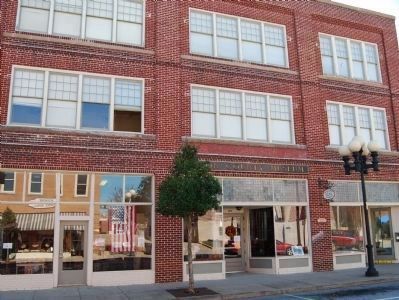
Photographed By Brian Scott, November 8, 2008
8. Union County Museum
A copy of the old County Jail marker is visible in the window to the right of the front entrance. Located on the first floor of the restored Flynn Office Building on historic Main Street, the building is the home the Museum and a source of great pride for the County and City of Union. (www.union-county-sc-museum.org)
Credits. This page was last revised on November 27, 2022. It was originally submitted on September 6, 2008, by M. L. 'Mitch' Gambrell of Taylors, South Carolina. This page has been viewed 1,763 times since then and 47 times this year. Photos: 1. submitted on September 6, 2008, by M. L. 'Mitch' Gambrell of Taylors, South Carolina. 2. submitted on November 11, 2008, by Brian Scott of Anderson, South Carolina. 3, 4. submitted on February 11, 2013, by Stanley and Terrie Howard of Greer, South Carolina. 5. submitted on September 7, 2008, by M. L. 'Mitch' Gambrell of Taylors, South Carolina. 6, 7, 8. submitted on November 12, 2008, by Brian Scott of Anderson, South Carolina. • Kevin W. was the editor who published this page.
